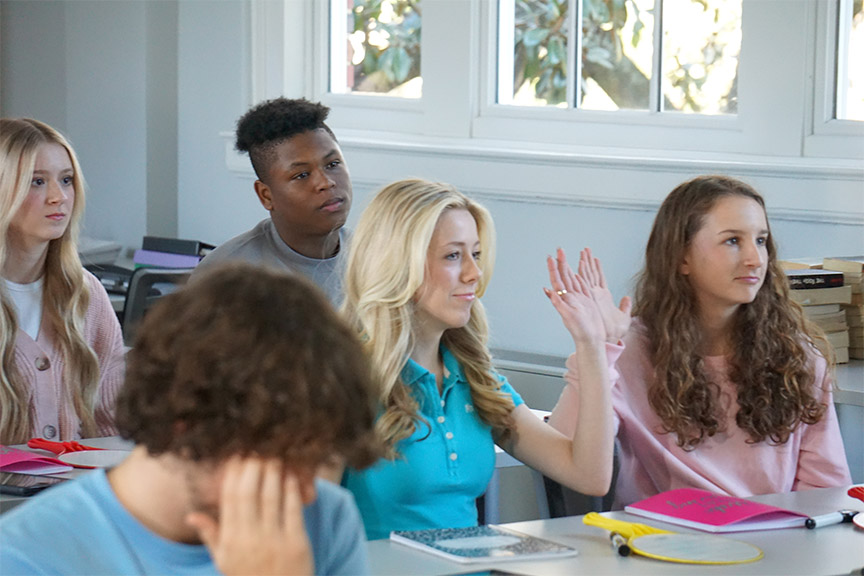What strategies can educators implement to prevent or address challenging behaviors?
Page 2: Behavior-Specific Praise
 Behavior-specific praise is a positive statement directed toward a student or group of students that acknowledges a desired behavior in specific, observable, and measurable terms. An educator using behavior-specific praise explicitly states the exact behavior the student demonstrated to meet expectations.
Behavior-specific praise is a positive statement directed toward a student or group of students that acknowledges a desired behavior in specific, observable, and measurable terms. An educator using behavior-specific praise explicitly states the exact behavior the student demonstrated to meet expectations.
By reinforcing positive behaviors, behavior-specific praise is a highly effective strategy that educators can use both to increase positive behavior and decrease challenging behaviors. Although educators can use general praise to reinforce student behavior, behavior-specific praise is proven to be a more effective strategy. In the table below, note that the examples of behavior-specific praise 1) identify the student who met the behavioral expectation and 2) clearly describe that behavior. In comparison, general praise could cause the students to wonder what it was they did well.
| General Praise | Behavior-Specific Praise |
| “Nice work, yesterday!” | “Julian, thank you for following my directions for partner work. I really enjoyed listening to the thoughtful feedback you gave Leilani.” |
| “Good job, Maya.” | “Maya, your thesis statement clearly introduces the topic to the reader. I can tell you spent a lot of time carefully developing it.” |
Research Shows
- The use of behavior-specific praise is linked to increased engagement and reduced disruptive behavior for secondary students.
(O’Handley, Olmi, Dufrene, Tingstrom & Whipple, 2022; Royer, Lane, Dunlap, & Ennis, 2019) - Behavior-specific praise can be effectively used to support students with or at risk for emotional and behavioral disorders (EBD).
(Downs, Caldarella, Larsen, Charlton, Wills, Kamps & Wehby, 2019; Allday, Hinkson-Lee, Hudson, Neilsen-Gatti, Kleinke, & Russel, 2012; Sutherland, Wehby, & Copeland, 2000)
Using the Strategy
To help educators prevent or address challenging behavior, the table below describes the steps to implement behavior-specific praise and provides an example.
| Steps | Description | Example |
|
Establish and explicitly teach behavioral expectations—the behaviors you want your students to display. |
The teacher identifies the following behavioral expectation. Classroom: Put away all cell phones and personal electronics. Because Taylor often takes out (and is distracted by) her cell phone during independent practice, the teacher establishes the following expectation for Taylor. Student: Taylor will keep her cell phone and all personal electronics in her backpack during independent practice. |
|
During instructional time, transitions, or down time, look for students engaging in the desired behaviors. | The teacher observes that Taylor keeps her cell phone in her backpack while working on her geometry assignment during independent practice. |
|
Frequently offer behavior-specific praise to the student by:
|
The teacher walks over to Taylor’s desk and discreetly says, “Taylor, I appreciate that you are keeping your cell phone in your backpack while you work on your assignment. You are much more focused today and your work reflects that.” |
In this video, Ms. Harris uses behavior-specific praise during small-group discussion (time: 1:36).
Transcript: Behavior-specific praise
Narrator: Behavior-Specific Praise—Note how the teacher identifies students engaging in desired behaviors, states each student’s name, and delivers praise that describes the behavior.
Teacher: Okay. Today we are going to be reading an informational text. Before you all read the text, I want you to make predictions about the author’s central idea. Take about 30 seconds, turn and talk to your partners, and discuss your predictions.
[Ava and Sam discuss their predictions about the text.]
Teacher: Ava and Sam, great job discussing your predictions!
Ava and Sam: Thank you.
[Ava and Sam continue to discuss their predictions.]
Teacher: Okay. Let’s bring it back to the front in five, four, three, two, one. Let’s hear some predictions!
[Sam raises his hand.]
Teacher: Yes, Sam!
Sam: Umm it seems like there’s a water shortage, and the author might be trying to warn us about the possibility of not having enough water to drink or use in certain parts of the country soon.
Teacher: Great prediction, Sam! I like that you took it a step further and also explained the author’s intention and purpose. I also like how you and Ava were working together to discuss that prediction. That’s what type of work we like to see during these quick discussions. Does anyone else have any predictions?
In addition to the three steps listed above, the four actions below can be helpful when implementing this practice.
Gather data or reflect on how often you offer general praise and behavior-specific praise to the student.
Example: A teacher (or paraeducator) marks a plus or a minus on a clipboard every time he gives general or behavior-specific praise to a student. He determines he is providing twice as many general statements compared to behavior-specific praise statements.
In the beginning it may feel fake or forced to use behavior-specific praise. Consider writing down a statement and practicing your praise out loud to become more comfortable and to make sure you are delivering it in a sincere tone of voice.
Self-monitor your use of praise by keeping a tally of praise statements during each class period to ensure at least a 4:1 ratio of praise to corrective statements. Students with challenging behavior often have difficulty meeting the established behavioral expectations and, therefore, have fewer opportunities to receive praise. As such, the teacher might need to offer praise more frequently, perhaps every few minutes. Once the student spends more time engaged in the desired behavior, the teacher can decrease the frequency of praise, though still maintaining a ratio of four praises for every one corrective statement.
Check in with students to see how comfortable they are with receiving behavior-specific praise. This can be done by speaking with students individually or asking the class to fill out a feedback form. To be effective, praise must be age- and developmentally appropriate. Middle and high school students may prefer subtle praise statements over more enthusiastic praise that occurs in front of the class. Regardless of age, some students may find verbal praise in front of others embarrassing. To meet the needs of these students, you can provide praise in a one-on-one setting or in a non-verbal manner (e.g., in a note).
In the first interview, Harold Holmes describes why it’s important to use behavior-specific praise equitably. Next, Yesmery Sanchez not only discusses the importance of using this strategy but also discusses how providing behavior-specific praise to one student can influence the behavior of other students.
Transcript: Harold Holmes
I think behavior-specific praise should be throughout the day. You quickly do it and you make sure that you’re doing it for everyone. You may have a kid who’s a frequent flier who always has problems. You may find that you’re not praising that student at all. This is the student who’s the loudest, who disrupts the most, and you may be happy that that student is quiet. A first-year teacher may think that if you’re giving positive praise to the kids who are acting right, you’re okay. But to the child, you’re just showing favoritism. So, I think behavior-specific praise should be done throughout, and it should be equitably applied for everyone, equally across the students, no matter how challenging they may be.
Transcript: Yesmery Sanchez
In high school, we still give those very specific praises. I think kids love that [laughs]. I can say like, “Hey, by the way, thank you for getting started right away. I appreciate you.” Or I’ll even shout them out in a more exaggerated way just because that’s the way that I am. I’m like “Oh my goodness, look at Johnny. He is on point today. Johnny, you get credit from me. You’re doing great.” I’ll really celebrate them when they’re doing the right thing. I want to keep the energy in the classroom light. I want to keep them happy and enjoying the class. But also I think it’s important to celebrate all the students and what they’re doing. And whether it’s small or big, regardless of their age, I think they appreciate hearing that somebody is acknowledging the work that they’re putting in or the difference that they have even in their behavior from maybe the day before. Students love specific praises, especially when they’re doing the right thing [laughs].
I feel that regardless of what you’re doing in the classroom, when you’re praising students, when they’re on the right track, I feel like they’re more likely to continue to have positive behaviors. I think also when other students see that praises are being given, they’re more likely also to want to receive a praise or want to be celebrated for the things they’re doing correctly. I don’t think we’re celebrated enough, and students aren’t always celebrated enough. So I think it’s great to constantly have the celebration going in class so they can continue to do what they have to do.
Tier 2 Support
Although behavior-specific praise can be used as a Tier 1 strategy, it can also be used as a Tier 2 support for students with moderate levels of externalizing or internalizing behaviors. The steps are the same as when used as a Tier 1 support, but for Tier 2 the educator delivers the praise with greater intensity (e.g., more frequently). To determine if the strategy is effective, the educator collects and analyzes the data using the following steps:
- Identify the student behavior to be addressed (e.g., student puts head down and refuses to work) during an instructional period in which the behavior typically occurs (e.g., science, math).
- Collect baseline data on the student behavior for a designated timeframe (e.g., first 20 minutes of class) during the identified instructional period. Collect this data across several days (e.g., 3 to 5 days) to see how often this behavior occurs or how long each episode lasts.
x
baseline data
The measure of the level of a student’s academic or behavioral performance before a change (e.g., instructional or behavioral practice or intervention) is implemented. This information can be compared to data collected after the change has been implemented to evaluate student progress.
- Implement or intensify behavior-specific praise and continue to collect data (e.g., same instructional period, same length of time) for 3 to 5 days to determine whether the student’s behavior changes.
- Evaluate the effect of behavior-specific praise. Compare the implementation data to the baseline data to evaluate whether the strategy has had the desired effect on the student’s behavior.
To learn more about identifying student behavior and collecting data, view these IRIS Case Studies:

To make sure you are using this strategy with fidelity, download this behavior-specific praise implementation checklist. To view our IRIS Fundamental Skill Sheets on behavior-specific praise, click on each title below. |

